Add this eBook to your basket to receive access to all 315 records. Our indexes include entries for the spelling veale. In the period you have requested, we have the following 315 records (displaying 231 to 240): These sample scans are from the original record. You will get scans of the full pages or articles where the surname you searched for has been found. Your web browser may prevent the sample windows from opening; in this case please change your browser settings to allow pop-up windows from this site. Ackworth Old Scholars: Yorkshire Quarterly Meeting
(1898)
The Quaker school at Ackworth in Yorkshire commenced in 1779. At the General Meeting of 1882 the Ackworth Old Scholars' Association was established, and a full list of members was printed in their annual proceedings. This list, corrected to 1 October 1898, gives full names (including married women's maiden surnames) and addresses, arranged, for those living in England, by quarterly meeting, and then with separate lists for England, Scotland, and other countries. We have indexed these separately, and included maiden surnames. | Sample scan, click to enlarge
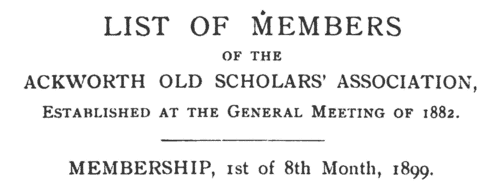
| Officers of the Royal Naval Reserve
(1898)
The Navy List, published by Authority, corrected to 18 December 1898, has this list of the officers on the Active List of the Royal Naval Reserve and of Honorary Officers of the reserve. Each officer's surname, christian name, and any middle initial(s) is given; with rank, and date of seniority in that rank. The ranks are: A E, Assistant Engineer; E, Engineer; Hon A P, Honorary Assistant Paymaster; Hon Ch E, Honorary Chief Engineer; Hon Cr, Honorary Commander; Hon L, Honorary Lieutenant; Hon P, Honorary Paymaster; Hon S L, Honorary Sub-Lieutenant; L, Lieutenant; Mid, Midshipman; S L, Sub-Lieutenant; Sen E, Senior Engineer. | Sample scan, click to enlarge
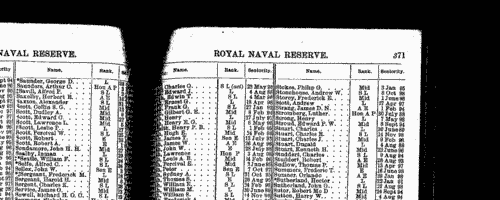
| Officers of the Royal Navy and the Royal Marines
(1898)
The Navy List, published by Authority, corrected to 18 December 1898, has this list of the officers on the Active List of the Royal Navy and the Royal Marines. Each officer's surname, christian name, and any middle initial(s) is given; with rank, date of seniority in that rank, and 'where serving', the last being the number of his ship. The ranks are: A, Admiral; A E, Assistant Engineer; A F, Admiral of the Fleet; A P, Assistant Paymaster; Art E, Artificer Engineer; As Ck, Assistant Clerk; B, Boatswain; Bandr, Bandmaster Royal Marines; C, Captain; Car, Carpenter; Ch, Chaplain; Ch B, Chief Boatswain; Ch Cr, Chief Carpenter; Ch E, Chief Engineer; Ch Gr, Chief Gunner; Ch P; Paymaster-in-Chief; Ck, Clerk; Cr, Commander; D I H, Deputy Inspector-General of Hospitals and Fleets; E, Engineer; E Ins, Inspector of Machinery; F E, Fleet Engineer; F P, Fleet Paymaster; F S, Fleet Surgeon; Gr, Gunner; H Sch, Head Schoolmaster; I H, Inspector-General of Hospitals and Fleets; L, Lieutenant; Mid, Midshipman; N C, Naval Cadet; N I, Naval Instructor; P, Paymaster; R A, Rear Admiral; S, Surgeon; S C, Staff-Captain; S Cr, Staff Commander; S E, Staff Engineer; S L, Sub-Lieutenant; S P, Staff Paymaster; S S, Staff Surgeon; Schm, Schoolmaster Royal Marines; St Ma, Sergeant Major Royal Marines; V A, Vice Admiral; W O, Warrant Officer Royal Marines. The column 'Where serving' also may have these abbreviations: AdC, Aide-de-Camp to the Queen; AO, Clerk to Secretary to a Flag Officer; CG, Coast Guard; CGP, Coast Guard Pension; DY, Dock Yard; GH, Greenwich Hospital; GHP, Greenwich Hospital Pension; GSP, Good Service Pension; NH, Naval Hospital; NID, Naval Intelligence Department; NP, Naval Pension (late Out-Pension of Greenwich Hospital); PW, Pension for Wounds; Sec, Secretary to a Flag Officer; TP, Travers Pension; TS, In the Transport Service; VY, Victualling Yard.
| Sample scan, click to enlarge
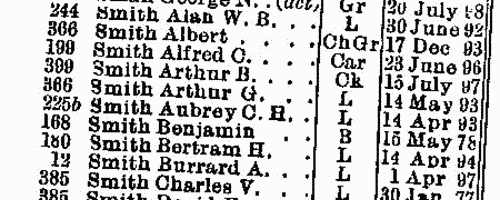
| Officers of the Royal Navy flying the Blue Ensign
(1898)
The Navy List, published by Authority, corrected to 18 December 1898, has this list of officers authorised to fly the Blue Ensign of Her Majesty's Fleet on their British Merchant Ships. Each officer's surname, christian name, and/or initial(s) is given; with rank, the name and official number of his vessel, and the number date of last issue of his Blue Ensign warrant. | Sample scan, click to enlarge

|  Outstanding soldiers of the Norfolk Regiment
(1881-1901) Outstanding soldiers of the Norfolk Regiment
(1881-1901)
Each year the best soldiers of the regiment were chosen for long service and good conduct medals. This register gives rank, name, regimental number, and date of recommendation. (The sample scan is from the East Surrey regiment). The register is essentially a register of recommendations, annotated with details of the issue of the medals. Where no gratuity accompanied the medal, the entry is marked 'W. G.' (without gratuity); where, for one reason or another, the medal was not issued, the entry is marked 'N. S.' (not sanctioned) and struck through. The regiment was based on the 9th Regimental District - Yarmouth, and then Norwich. The 1st battalion returned from the Cape of Good Hope in August 1870, and in 1885 was stationed at Gosport. It embarked for Gibraltar in 1887, and thence to India. By 1895 the battalion was serving at Umballa. The 2nd battalion embarked for India 23 October 1874 and in 1885 was at Morar in Bengal; it was moved to Burmah in 1888, from which it returned to England in 1890. In 1895 the 2nd battalion was stationed at Aldershot. In 1897 it was moved to Ireland, and from there to South Africa in 1900, adding "South Africa, 1900-1902" and "Paardeberg" to the regimental honours.
| Sample scan, click to enlarge
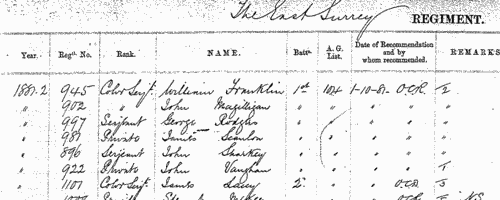
|  Outstanding soldiers of the Royal Welsh Fusiliers
(1881-1901) Outstanding soldiers of the Royal Welsh Fusiliers
(1881-1901)
Each year the best soldiers of the regiment were chosen for long service and good conduct medals. This register gives rank, name, regimental number, and date of recommendation. (The sample scan is from the East Surrey regiment). The register is essentially a register of recommendations, annotated with details of the issue of the medals. Where no gratuity accompanied the medal, the entry is marked 'W. G.' (without gratuity); where, for one reason or another, the medal was not issued, the entry is marked 'N. S.' (not sanctioned) and struck through. The regiment was based on the 23rd Regimental District - Wrexham. The 1st battalion embarked for Bengal in 1880, and by 1885 was stationed at Dum Dum; it was transferred to Burma for the campaign of 1885 to 1886 ("Burma, 1885-1887"), returning to India in 1887. The battalion took part in the Hazara Expedition of 1891. In 1895 it was at Jhansi. The troops returned to England via Aden in 1897, but were dispatched to South Africa in 1899, where they added "South Africa, 1899-1900" and "Relief of Ladysmith" to the regimental honours. The 2nd battalion returned to England from Gibraltar in 1880, was transferred to Ireland in 1883, and was at Templemore in 1885. The battalion returned to England in 1892, and was at Manchester in 1895. In 1896 the 2nd battalion was sent out to Malta, where it took part in the occupation of Crete; and on to Hong Kong in 1898, fighting in China and adding "Pekin, 1900" to the colours. | Sample scan, click to enlarge
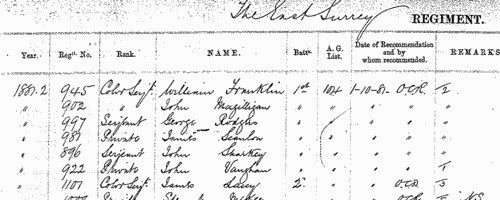
| Unclaimed Naval Prize Money
(1855-1902)
Various prize moneys were awarded to officers and men who served on board her Majesty's ships. For one reason or another a substantial number of these prizes, from as little as a shilling or two to as much as many pounds, remained undistributed by 1902, when this comprehensive list of the unclaimed moneys was printed: it lists unclaimed shares of prize money, slave and pirate bounties, salvage awards, parliamentary grants, gratuities and other moneys distributed by the Admiralty 1855 to 1902, but which omits moneys for service on the China Station during the war of 1856 to 1880, and special gratuities for service in Egypt (1882), Soudan (1884) and Soudan and Nile Expedition (1884-1885), for which there are separate indexes. In each case the sailor's name is given first (surname, then christian name or initials); rank or rating; ship in which serving at time of capture or award; and the amount due. | Sample scan, click to enlarge

|  London Metropolitan Police
(1892-1902) London Metropolitan Police
(1892-1902)
The London Metropolitan Police Register of Joiners (MEPO 4/336) lists policemen joining the force 1 January 1892 to 23 June 1902 (warrant numbers 77319 to 88811). The register is alphabetical, in so far as the recruits are listed chronologically grouped under first letter of surname. It gives Date of Appointment, Name, Number of Warrant, Cause of Removal from Force (resigned, dismissed, promoted or died), and Date of Removal. A final column of 'Remarks' is largely blank, but occasionally gives an alias or a cross-reference to another warrant number. | Sample scan, click to enlarge

|  British artillerymen fighting in South Africa
(1899-1902) British artillerymen fighting in South Africa
(1899-1902)
The Queen Victoria's South Africa Medal was awarded (after her death, in the event) to all who had served honourably in the various campaigns in the Boer War. Returns were made from each unit, and consolidated into nominal roll, of which this is the one for the Royal Artillery. Confusingly, the ledgers used had originally been printed for a register of men transferred (or re-transferred after mobilization) to 1st Class Army Reserve. All the original column headings were therefore struck through, and the roll was prepared with this information: Date of Issue; Regimental Number; Rank; Name; Unit; Medal (a 1 indicating that a medal was awarded); [number of] Clasps; the reference to the source in the original returns, usually starting with AG for papers in the hands of the Adjutant-General, and 68/Art/ for the Royal Artillery records. The final column, normally left blank, was occasionally used for explanatory remarks. | Sample scan, click to enlarge

| Boys entering Sherborne School
(1904)
The grammar school at Sherborne in Dorset, which doubtless existed from the creation of the diocese of Sherborne in 705, was refounded by king Edward VI in 1550. At the quatercentenary in 1950, a fourth edition of the Sherborne Register was published, listing boys entering the school during those four centuries. In truth, the materials for this register survive but fitfully before 1823; for some years, no names are known; sometimes all that is known is a surname. But from 1823 onwards the lists and the details get steadily more comprehensive. By the 20th century the boys are listed alphabetically by surname under term of entrance. Surname is given in bold, then christian names, name of father (surname and initials) and address; year of birth; house (a, School House; b, Abbey House; c, The Green; d, Harper House (formerly The Retreat); f, Abbeylands; g, Lyon House; h, Westcott House); whether represented the school at cricket (xi), football (xv), shooting (viii), &c.; year of leaving; summary of degrees, career &c.; and (in italics), address as of 1950. Names in the early lists marked with an asterisk are found inscribed on the oak panelling or on the stone walls of the former schoolroom. (F) in the lists indicates a foundationer, receiving free education: after 1827, when this privilege was restricted to boys from Sherborne and neighbourhood, nearly all foundationers were day-boys. | Sample scan, click to enlarge
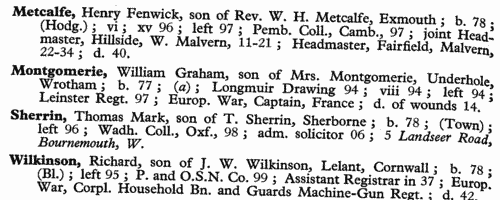
|
Research your ancestry, family history, genealogy and one-name study by direct access to original records and archives indexed by surname.
|












